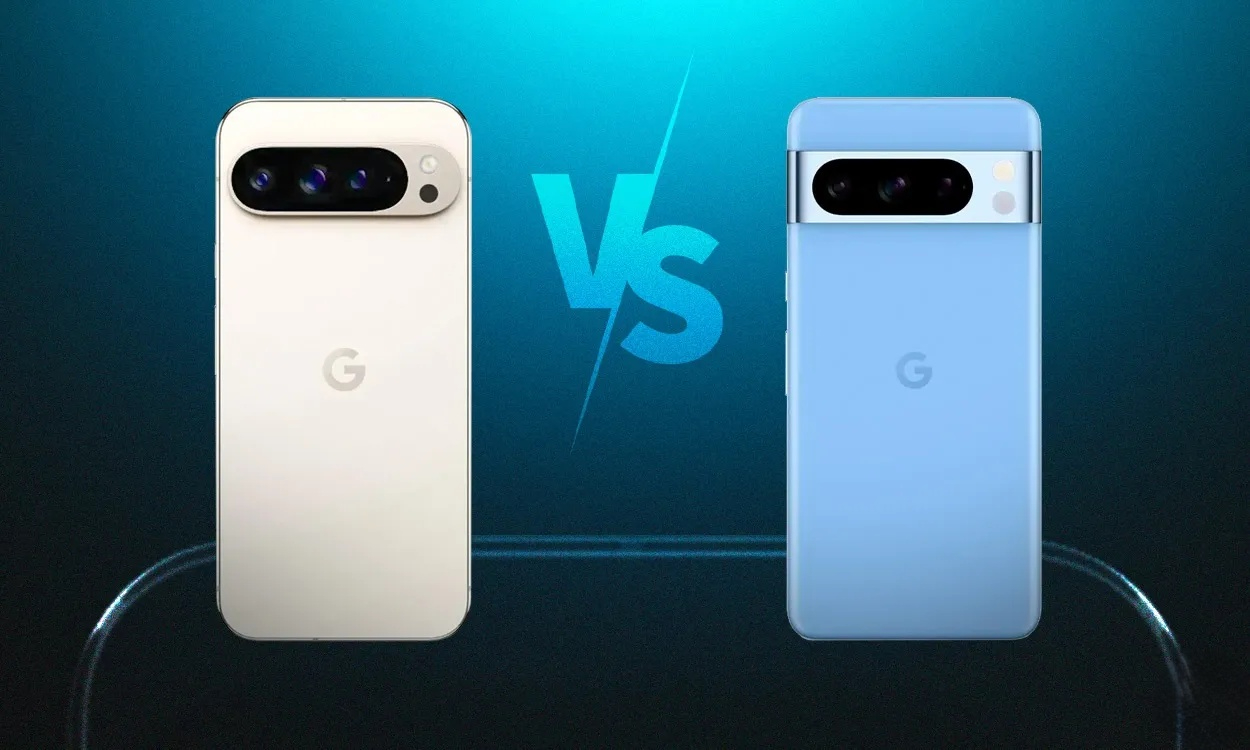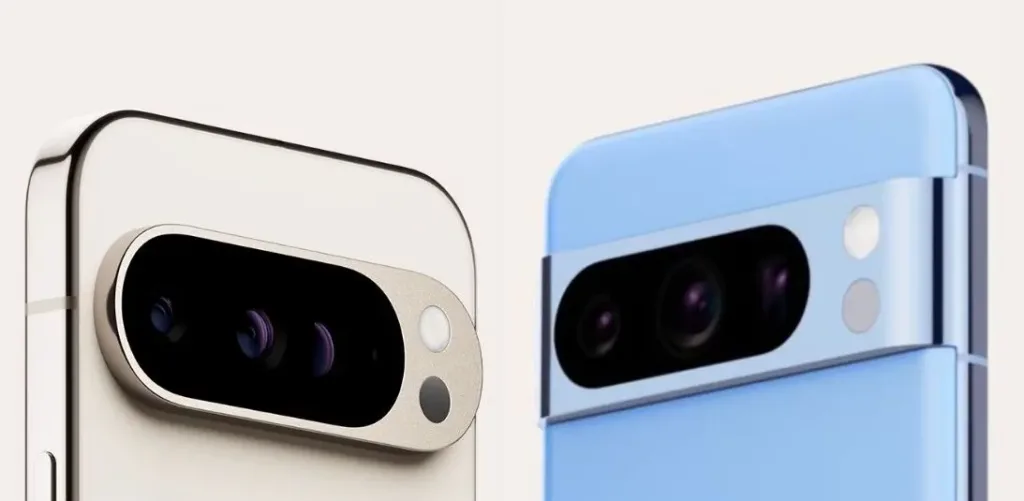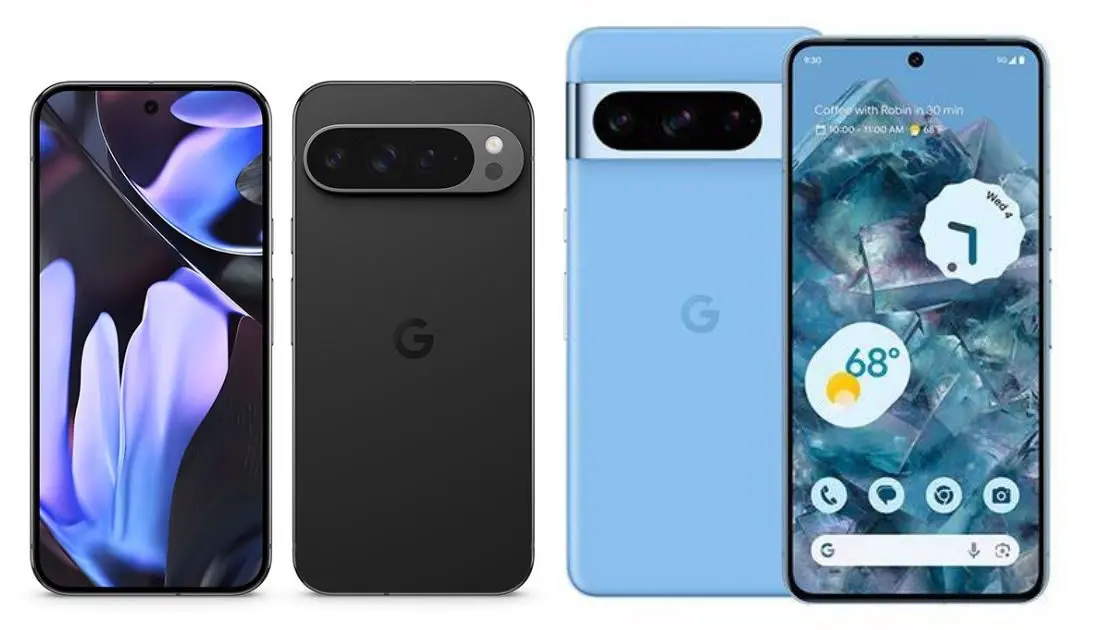
The Pixel 8 Pro was renowned for its outstanding photo capabilities and setting a high standard for Android updates. With the Pixel 9 Pro and XL, Google aims to surpass that benchmark. The new Google Pixel features a refreshed design, additional color options, and upgraded specs, but is it worth upgrading from the Pixel 8 Pro? You might have an idea already, but read on for a detailed comparison to find out. Here’s our Pixel 9 Pro vs. Pixel 8 Pro showdown.
Build and Design
The Pixel 9 Pro, measuring 152.8 x 71.9 x 8.5 mm, is notably smaller and more pocket-friendly compared to the Pixel 8 Pro, which has dimensions of 162.6 x 76.5 x 8.8 mm. This size difference makes the Pixel 9 Pro more compact, whereas the Pixel 8 Pro is more aligned in size with its true successor, the Pixel 9 Pro XL.

Both models feature an aluminum chassis with matte back glass and glossy frames. However, the Pixel 9 Pro upgrades to Corning Gorilla Glass Victus 2 on both the front and back, while the Pixel 8 Pro is equipped with the previous generation Gorilla Glass Victus.
The design differences between the Pixel 9 Pro and Pixel 8 Pro are quite noticeable. The Pixel 9 Pro features slightly more curved screen edges and a boxier overall design compared to the Pixel 8 Pro. This change may be viewed positively or negatively, depending on personal preference. In my view, the Pixel 8 Pro’s design felt more quintessentially Pixel, whereas the Pixel 9 Pro appears to draw some inspiration from iPhones.

Another significant difference is in the camera module design. The Pixel 8 Pro’s camera bar extends seamlessly to the sides, while the Pixel 9 Pro features a distinct island-style camera module. The Pixel 8 Pro’s design was more original, starting with the Pixel 6, but the Pixel 9 Pro’s camera design also integrates well with the overall look of the device.
Display
The Pixel 9 Pro features a 6.34-inch 1.5K 120Hz LTPO OLED (Super Actua) display with a resolution of 1280 x 2856 pixels. It offers a peak HDR brightness of 2,050 nits and up to 3,000 nits in direct sunlight.

In contrast, the Pixel 8 Pro comes with a larger 6.7-inch 120Hz LTPO OLED display, with a resolution of 1344 x 2992 pixels and a peak brightness of 2,400 nits. The Pixel 9 Pro utilizes Samsung’s latest M14 panel, which is designed to be more vibrant.
While the Pixel 9 Pro’s Super Actua panel is brighter, display brightness might not be a critical factor for everyone. Aside from this improvement, there isn’t a substantial difference between the two displays that would make one a clear choice over the other.
Hardware, Storage, & RAM
The base model of the Pixel 9 Pro features 128GB of UFS 3.1 storage and 16GB of LPDDR5 RAM. The higher storage variants are equipped with UFS 4.0. It’s a bit disappointing that Google has maintained 128GB as the base storage for the Pixel 9 Pro, but the upgrade to UFS 4.0 is appreciated. UFS 4.0 offers a significant improvement in read/write speeds and power efficiency compared to UFS 3.1.
The Pixel 9 Pro is driven by the Tensor G4 chip, which has a 1+3+4 core configuration: 1 Cortex X4 core clocked at 3.1 GHz, 3 Cortex-A720 cores at 2.6 GHz, and 4 Cortex-A520 cores at 1.95 GHz. Additionally, the ARM Mali-A715 GPU now operates at a higher clock speed of 940 MHz.

In comparison, the Pixel 8 Pro features the Tensor G3 chip with a 1+4+4 configuration: 1 Cortex-X3 core at 2.91 GHz, 4 Cortex-A715 cores at 2.37 GHz, and 4 Cortex-A510 cores at 1.7 GHz. The ARM Mali-A715 GPU in the Pixel 8 Pro is clocked at 890 MHz.
On paper, the Tensor G4 in the Pixel 9 Pro is expected to deliver around a 10% increase in performance. However, actual performance gains can vary significantly depending on how Google optimizes the OS and hardware.
The Pixel 8 Pro’s Tensor G3 has been known to throttle to conserve battery and manage heat, and without a substantial cooling upgrade, the Pixel 9 Pro might face similar issues with the Tensor G4. Overall, while the Tensor G4 is touted as an improvement, its performance capabilities remain somewhat uncertain.
Cameras
The Pixel 8 Pro features a primary 50 MP f/1.7 sensor, a secondary 48 MP f/1.95 Ultrawide sensor, and a 48 MP f/2.8 Telephoto sensor. The Pixel 9 Pro also includes a 50 MP wide Samsung GNK sensor, but it upgrades the Ultrawide camera from a Sony IMX386 to a new IMX858, which is slightly larger at 1/2.51″. The Telephoto lens remains a 48 MP sensor with 5X zoom, similar to the previous model.

The front camera on the Pixel 9 Pro has been upgraded to a 42 MP sensor, a significant increase from the older 10.5 MP Samsung 3J1. Overall, the Pixel 9 Pro’s cameras should deliver more detailed images and perform better in low-light conditions, thanks to the improved sensor size and resolution.
Battery and Charging
The Pixel 8 Pro comes with a 5,050 mAh battery that charges at 30W, while the Pixel 9 Pro features a smaller 4,700 mAh battery but compensates with faster 45W charging. The Pixel 9 Pro XL, which serves as the true successor to the 8 Pro, includes a larger 5,060 mAh battery.
The Pixel 9 Pro’s smaller battery and faster charging speed mean it will charge more quickly, but the Pixel 8 Pro still has a slight advantage in battery life due to its larger capacity.
Connectivity and Exclusive Features

Both the Pixel 8 Pro and Pixel 9 Pro support Wi-Fi 6, Bluetooth 5.4, USB 3.2 Type-C, and NFC. However, the Pixel 9 Pro introduces Satellite Connectivity out of the box and features the new Exynos 5400 modem, which should address existing network issues. Unfortunately, Google has not confirmed if older Pixel models will receive this upgrade or if they have the necessary hardware.
The Pixel 9 Pro will also benefit from exclusive features such as a year of Gemini Advanced, along with new software enhancements like Add Me, Pixel Screenshots, Pixel Studio, and various AI capabilities including image-to-text and Gemini Nano. Google typically extends new features to older Pixel devices, and since most of these updates are software-based rather than hardware-dependent, there is a good chance they will become available for previous models as well.
Our Verdict
For the same $999 price as the Pixel 8 Pro, the Pixel 9 Pro offers notable upgrades in display, charging, and camera performance, along with a more compact design. However, these improvements are incremental rather than groundbreaking.
The Pixel 9 Pro ships with Android 14, making it the first new Pixel to launch without the latest Android version. With Android 15 on the horizon, this means the Pixel 9 Pro will receive updates for 6 years instead of the full 7-year support. The Pixel 8 Pro still boasts excellent cameras, a larger display, and a bigger battery. Unless you find a compelling trade-in offer or prefer a more compact device, sticking with the Pixel 8 Pro is a solid choice.



